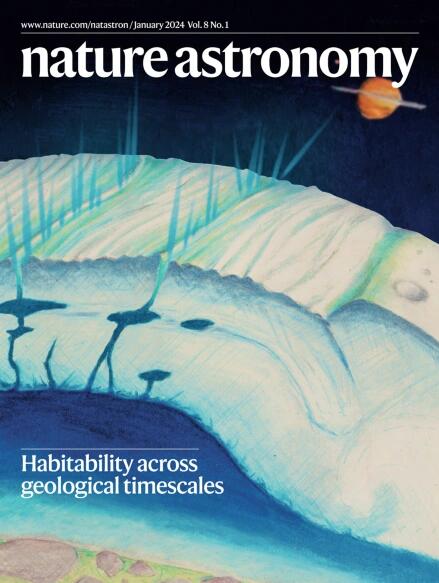TRAPPIST-1 b卫星12.8和15 μm JWST/MIRI日食观测数据的综合分析
IF 12.9
1区 物理与天体物理
Q1 ASTRONOMY & ASTROPHYSICS
引用次数: 0
摘要
詹姆斯-韦伯太空望远镜/MIRI 对 TRAPPIST-1 b 的首次光度观测发现了这颗行星在 15 μm 波段的热辐射,表明这颗行星可能是一块裸岩,反照率为零,没有热量再分布。这些 15 μm 波段的观测数据是作为 "保证时间观测 "时间的一部分获得的,其中包括一个 12.8 μm 波段的孪生计划,以获得二氧化碳吸收波段内外的测量数据。在这里,我们介绍用 MIRI 在 12.8 μm 的额外测光波段观测到的 TRAPPIST-1 b 的五次新掩星。我们对这十次掩星进行了全局拟合,得出在 12.8 μm 和 15 μm 波段行星与恒星的通量比和 1σ 误差分别为 452 ± 86 ppm 和 775 ± 90 ppm。我们发现出现了两种主要情况。一种是无空气的行星模型,其表面是未风化的(新鲜的)超基性岩,这可能表明了相对较新的地质过程,与数据非常吻合。另一种情况是,厚厚的纯二氧化碳大气层中存在光化学烟雾,这种烟雾会造成温度反转,从而导致在发射中出现二氧化碳特征,这种情况也是可行的,但需要注意一些问题。我们的研究结果凸显了仅凭宽带滤波器对行星发射的测量结果来准确判断其大气或表面性质所面临的挑战,但同时也指出了两种非常有趣的情况,我们将通过即将公布的 TRAPPIST-1 b 相位曲线来进一步研究这两种情况。本文章由计算机程序翻译,如有差异,请以英文原文为准。


Combined analysis of the 12.8 and 15 μm JWST/MIRI eclipse observations of TRAPPIST-1 b
The first James Webb Space Telescope/MIRI photometric observations of TRAPPIST-1 b allowed for the detection of the thermal emission of the planet at 15 μm, suggesting that the planet could be a bare rock with a zero albedo and no redistribution of heat. These observations at 15 μm were acquired as part of Guaranteed Time Observer time that included a twin programme at 12.8 μm to obtain measurements inside and outside the CO2 absorption band. Here we present five new occultations of TRAPPIST-1 b observed with MIRI in an additional photometric band at 12.8 μm. We perform a global fit of the ten eclipses and derive a planet-to-star flux ratio and 1σ error of 452 ± 86 ppm and 775 ± 90 ppm at 12.8 μm and 15 μm, respectively. We find that two main scenarios emerge. An airless planet model with an unweathered (fresh) ultramafic surface, that could be indicative of relatively recent geological processes, fits the data well. Alternatively, a thick, pure-CO2 atmosphere with photochemical hazes that create a temperature inversion and result in the CO2 feature being seen in emission also works, although with some caveats. Our results highlight the challenges in accurately determining a planet’s atmospheric or surface nature solely from broadband filter measurements of its emission, but also point towards two very interesting scenarios that will be further investigated with the forthcoming phase curve of TRAPPIST-1 b. Simultaneous observations of TRAPPIST-1 b from JWST at 12.8 and 15 μm indicate that it is probably a bare rock with a mineral-rich surface. However, an alternative scenario with a CO2-rich atmosphere and hazes could also explain the observations.
求助全文
通过发布文献求助,成功后即可免费获取论文全文。
去求助
来源期刊

Nature Astronomy
Physics and Astronomy-Astronomy and Astrophysics
CiteScore
19.50
自引率
2.80%
发文量
252
期刊介绍:
Nature Astronomy, the oldest science, has played a significant role in the history of Nature. Throughout the years, pioneering discoveries such as the first quasar, exoplanet, and understanding of spiral nebulae have been reported in the journal. With the introduction of Nature Astronomy, the field now receives expanded coverage, welcoming research in astronomy, astrophysics, and planetary science. The primary objective is to encourage closer collaboration among researchers in these related areas.
Similar to other journals under the Nature brand, Nature Astronomy boasts a devoted team of professional editors, ensuring fairness and rigorous peer-review processes. The journal maintains high standards in copy-editing and production, ensuring timely publication and editorial independence.
In addition to original research, Nature Astronomy publishes a wide range of content, including Comments, Reviews, News and Views, Features, and Correspondence. This diverse collection covers various disciplines within astronomy and includes contributions from a diverse range of voices.
 求助内容:
求助内容: 应助结果提醒方式:
应助结果提醒方式:


